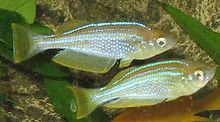The Tanganyika killifish (Lamprichthys tanganicanus) is a species of poeciliid endemic to Lake Tanganyika, where it forms large schools, mainly close to rocky shores but also pelagically off shore. This species grows to a length of 15 centimetres (5.9 in) SL. It is an egglayer with external fertilization, and deposits its eggs in narrow crevices. It is fished commercially for food, and also for the aquarium trade. It has been introduced to Lake Kivu.[2]
| Tanganyika killifish | |
|---|---|

| |
| Scientific classification | |
| Domain: | Eukaryota |
| Kingdom: | Animalia |
| Phylum: | Chordata |
| Class: | Actinopterygii |
| Order: | Cyprinodontiformes |
| Family: | Poeciliidae |
| Subfamily: | Procatopodinae |
| Tribe: | Procatopodini |
| Genus: | Lamprichthys Regan, 1911 |
| Species: | L. tanganicanus
|
| Binomial name | |
| Lamprichthys tanganicanus (Boulenger, 1898)
| |
References
edit- ^ Ntakimazi, G. (2006). "Lamprichthys tanganicanus". IUCN Red List of Threatened Species. 2006: e.T60429A12365130. doi:10.2305/IUCN.UK.2006.RLTS.T60429A12365130.en. Retrieved 15 November 2021.
- ^ Froese, Rainer; Pauly, Daniel (eds.). "Lamprichthys tanganicanus". FishBase. August 2019 version.
